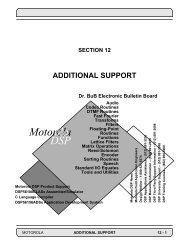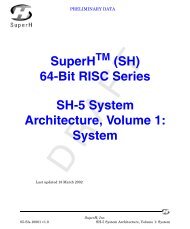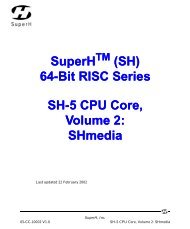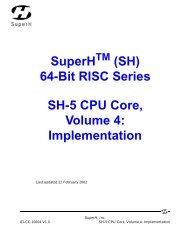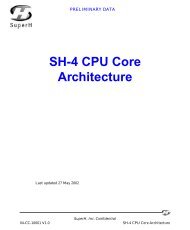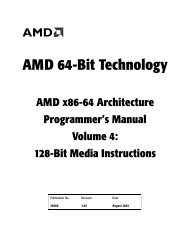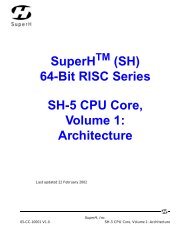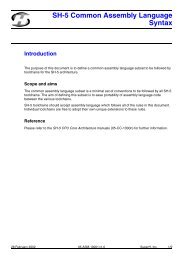SuperH (SH) 64-bit RISC Series SH-5 System Architecture, Volume ...
SuperH (SH) 64-bit RISC Series SH-5 System Architecture, Volume ...
SuperH (SH) 64-bit RISC Series SH-5 System Architecture, Volume ...
You also want an ePaper? Increase the reach of your titles
YUMPU automatically turns print PDFs into web optimized ePapers that Google loves.
PRELIMINARY DATA<br />
66 WP channel matching<br />
1.6 WP channel matching<br />
The following subsections and diagram explain how watchpoint channel matching is<br />
achieved. Where:<br />
PRE = precondition register (WPC or DM as appropriate),<br />
ACTION = action register (WPC or DM as appropriate).<br />
1.6.1 SR.WATCH <strong>bit</strong><br />
The SR.WATCH <strong>bit</strong> is used to enable or disable all actions related to WPC-based WP<br />
channels (IA, OA, IV, BR, WPC_PERF) in both the WPC and the DM. It has no effect<br />
on the other WP channels (BRK, FPF, PL, DM).<br />
If SR.WATCH is ‘0’, all the action conditions (Section 1.5: Debug event actions on<br />
page 48) associated with all the WPC-based WP channels defined above are<br />
disabled. Thus these channel’s actions which would normally launch the event<br />
handler, affect event/performance counters, chain latches, trigger out pins or<br />
generate trace for example, will be voided.<br />
SR.WATCH is automatically cleared to ‘0’ by the hardware when launching a reset,<br />
panic or debug event handler. This allows all instructions executed within the event<br />
handler to be invisible to the debug system itself in order to prevent generation of<br />
unwanted trace, and to prevent the CPU from trying to launch a debug exception<br />
during the execution of the event handler itself.<br />
This may appear to be a nontypical situation (that is, breakpoints would not be set<br />
in the debug event handler code), but unexpected exceptions might occur due to<br />
“wide” programming of IA/OA and particularly IV watchpoint channels.<br />
Event handler software should re-enable action conditions by restoring SR.WATCH to<br />
‘1’ when leaving its critical region. This is achieved using the RTE instruction to<br />
write the contents of the saved status register (SSR) to the status register (SR). This<br />
will not result in the BR channel triggering for the branch caused by the RTE<br />
instruction, as the state of SR.WATCH is considered at the start of an RTE<br />
instruction’s execution (see WP channel type BR on page 156).<br />
D R A FT<br />
<strong>SuperH</strong>, Inc.<br />
<strong>SH</strong>-5 <strong>System</strong> <strong>Architecture</strong>, <strong>Volume</strong> 3: Debug 05-SA-10003 v1.0



